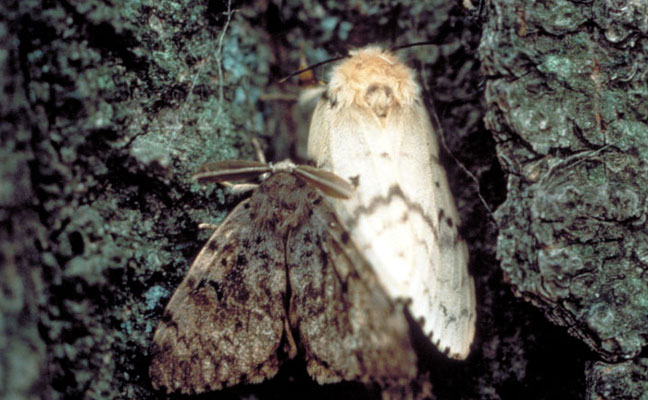
The EDA renamed the moth species Lymantria dispar to “spongy moth.” Photo: John Ghent, John Ghent, Bugwood.org
The moth species Lymantria dispar has been given a new common name by the Entomological Society of America (ESA).
The ESA Governing Board voted unanimously last week to approved the addition of “spongy moth” to ESA’s Common Names of Insects and Related Organisms List, completing a process started in July 2021.
The previous common name, “gypsy moth,” was removed due to its use as a derogatory term for the Romani people. The change is the first undertaken by ESA’s Better Common Names Project.
The name — derived from the common name used in France and French-speaking Canada, “spongieuse” — refers to the moth’s sponge-like egg masses.
“Lymantria dispar is a damaging pest in North American forests, and public awareness is critical in slowing its spread. ‘Spongy moth’ gives entomologists and foresters a name for this species that reinforces an important feature of the moth’s biology and moves away from the out-dated term that was previously used,” ESA President Dr. Jessica Ware said in a news release. “We are grateful to the diverse community of people and organizations who have been involved in this renaming process and have committed to adopting ‘spongy moth’ as well.”
The spongy moth is an invasive pest of North American forests that can defoliate hundreds of tree and shrub species. Native to Europe, Asia and North Africa, it was introduced in Massachusetts in the 1800s and is now widespread in the northeastern United States and eastern Canada. The moth costs hundreds of millions of dollars each year in damage and prevention and control efforts.
The primary way the spongy moth spreads is via egg masses when transported on firewood, outdoor equipment and vehicles. Public awareness of the Lymantria dispar egg mass and its sponge-like appearance is important in controlling the pest, as the insect spends most of its life cycle (10 months) in the egg stage.
Through its addition to the ESA Common Names List, “spongy moth” will now be adopted for use in articles published in ESA’s scientific journals and in presentations and posters at ESA conferences, as well as in ESA’s website, social media and public policy documents.
ESA encourages other organizations and individuals who work in research or management of Lymantria dispar to transition to the use of “spongy moth” in communications, documents and publications as time and resources allow in coming months and years.
The Better Common Names Project has published a toolkit for adopting the new name, with recommendations, frequently asked questions and a flyer for raising public awareness.
The name “spongy moth” was recommended by a working group that included more than 50 scientists and professionals who work in research or forest management settings in both the United States and Canada, as well as Romani scholars working on human rights issues.
The group gathered name suggestions and additional input from a broad array of interested individuals and organizations, including entomologists, forestry professionals, federal agencies, state departments of agriculture and natural resources, conservation groups, pest control and plant protection organizations, and Romani people.
More than 200 name proposals were evaluated, and a list of seven finalist names was shared with these groups for consideration, with more than 1,000 responses received. “Spongy moth” was put forth for a two-week comment period beginning Jan. 25, and comments were reviewed by the ESA Common Names Committee and ESA Governing Board prior to final approval.
The post <i>Lymantria dispar</i> renamed by the Entomological Society of America appeared first on Pest Management Professional.
from Pest Management Professional https://www.mypmp.net/2022/03/03/lymantria-dispar-renamed-by-the-entomological-society-of-america/
Sacramento CA
No comments:
Post a Comment